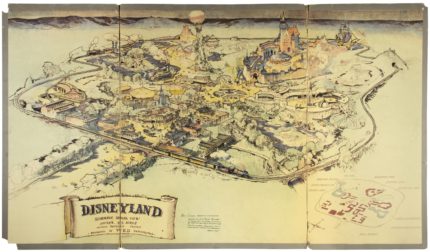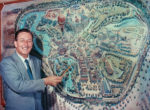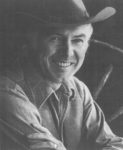
The first map of Disneyland, created in a single frenetic weekend of 1953 by Walt Disney and Disney artist Herb Ryman, sold at a Van Eaton Galleries auction in Los Angeles on Sunday for $708,000. That’s on the low-end of the $700,000 to $900,000 pre-sale estimate — some breathless reports before the auction suggested the price could top $1 million — but it still sets a record for the most expensive Disneyland map ever sold, even though it’s not an actual map of the real life Disneyland.
The map was created to use in a pitch to a potential investor, the television studio ABC which was then just five years old. Walt Disney’s idea for a theme park nestled in the orange groves of Anaheim, California, sounded like a cockamamie scheme to most money people and Walt and his brother Roy were repeatedly turned down. Walt was so convinced this was a winning idea that he refinanced his home to raise money for the enterprise, but it wasn’t anywhere near enough. Construction of Disneyland would cost $17 million and to convinced financial types to invest that kind of money, Walt realized he needed to create a visual representation of his idea so they could get it without having to use their limited imaginations.
 On September 26th and 27th, 1953, the weekend before Roy Disney’s pitch meeting with ABC executives in New York City, Walt Disney and Herb Ryman sealed themselves in to a room at Disney Studio a drew up a map. Disney told Ryman what to draw, and Ryman penciled his boss’ vision on a sheet of vellum. He then transferred the drawing to more durable paper and hand-inked and colored it. The map was mounted on a three-fold presentation board and Roy Disney hustled it off to New York to present Walt’s vision to the ABC people. It worked. In exchange for a Disney-produced TV series to be aired on the network, ABC agreed to finance the construction of Disneyland, still the biggest network deal in history adjusted for inflation. (Disney bought all of ABC’s shares of Disneyland in 1960 and 36 years later bought ABC itself.)
On September 26th and 27th, 1953, the weekend before Roy Disney’s pitch meeting with ABC executives in New York City, Walt Disney and Herb Ryman sealed themselves in to a room at Disney Studio a drew up a map. Disney told Ryman what to draw, and Ryman penciled his boss’ vision on a sheet of vellum. He then transferred the drawing to more durable paper and hand-inked and colored it. The map was mounted on a three-fold presentation board and Roy Disney hustled it off to New York to present Walt’s vision to the ABC people. It worked. In exchange for a Disney-produced TV series to be aired on the network, ABC agreed to finance the construction of Disneyland, still the biggest network deal in history adjusted for inflation. (Disney bought all of ABC’s shares of Disneyland in 1960 and 36 years later bought ABC itself.)
In October, Roy brought the map back to California where it was used throughout 1953 and 1954 to show designers, investors, engineers and artists what Walt had in mind. It was altered several times in 1954 — lines darkened, colors added, new cars hooked up to the train, the scroll gussied up — and was repeatedly featured in the advanced publicity materials from September 19th, 1954, until the park’s opening on July 15th, 1955.
It didn’t keep up with the planning, though. Land of Tomorrow on the map became Tomorrowland in the park. Frontier Country became Frontierland. Lilliputian Land never happened at all. Sleeping Beauty Castle, the center point of Disneyland, is way at the back of the park in the concept map. The train station and Main Street square do match up with the real Disneyland.
Even though the map had been essential to securing the funding for Walt Disney’s brainchild and in promoting it in the months before its opening, Walt gave it away without hesitation before the park was even completed. The lucky recipient was one Grenade Curran, a show business veteran and jack of all trades who worked at Walt Disney Studios.
 Grenade’s father was Charles Curran, an adept with the hand-held camera who became both Clark Gable’s and Roy Rogers’ personal cameraman. His mother had been an MGM dancer in her youth and had a very successful later career in the studio’s scenic art department. With an uncle and cousin in the business as well, Grenade grew up on the backlots of Hollywood. He was buddies with some of the most famous actors of all time and their children. From the time he was a baby, he was in front of the camera in commercials and movies. As an adult, he followed in his mother’s proverbial footsteps and worked as a background dancer in classic MGM musicals like Singin’ in the Rain, Seven Brides for Seven Brothers and The Band Wagon. Over his decades in the business, he also worked behind the camera, touching every aspect of production from wardrobe to set design to direction.
Grenade’s father was Charles Curran, an adept with the hand-held camera who became both Clark Gable’s and Roy Rogers’ personal cameraman. His mother had been an MGM dancer in her youth and had a very successful later career in the studio’s scenic art department. With an uncle and cousin in the business as well, Grenade grew up on the backlots of Hollywood. He was buddies with some of the most famous actors of all time and their children. From the time he was a baby, he was in front of the camera in commercials and movies. As an adult, he followed in his mother’s proverbial footsteps and worked as a background dancer in classic MGM musicals like Singin’ in the Rain, Seven Brides for Seven Brothers and The Band Wagon. Over his decades in the business, he also worked behind the camera, touching every aspect of production from wardrobe to set design to direction.
In 1954 he got his first job with Walt Disney Studios working as a safety diver on 20,000 Leagues Under the Sea starring Kirk Douglas. Several other behind-the-scenes jobs followed in Disney pictures and television shows. Walt Disney knew Curran’s family and he took a liking to Grenade, not the least because of his undeniably kickass first name. So even though he was just a regular production guy, not an executive, animator or an artist, Grenade found himself in the middle of historic events thanks to that jocular rapport he had with Disney.
After the deal was struck in New York, Walt Disney showed Grenade the first check from ABC and the check the mortgage company gave him when he refinanced his home. Grenade also saw the map, witnessing artists make changes and additions at Disney’s command. In March of 1955, Grenade asked him what he planned to do with the map and then boldly asked if he could have it. Walt said yes and Grenade Curran became the proud owner of the first map of Disneyland.
 Construction on the park began in 1954 and on July 15th, 1955, Disneyland had its World Premiere Invitational Opening broadcast live on television and hosted by Art Linkletter, Ronald Reagan and Robert Cummins. Walt Disney assigned Grenade Curran to drive one of the Autopia cars in the very first Main Street Parade led by Mickey Mouse and Donald Duck. Actor Don DeFore road in the car with him.
Construction on the park began in 1954 and on July 15th, 1955, Disneyland had its World Premiere Invitational Opening broadcast live on television and hosted by Art Linkletter, Ronald Reagan and Robert Cummins. Walt Disney assigned Grenade Curran to drive one of the Autopia cars in the very first Main Street Parade led by Mickey Mouse and Donald Duck. Actor Don DeFore road in the car with him.
The opening was supposed to be an invitation-only preview, a show for celebrities and tantalizing glimpse brought to the rest of the country by ABC, but word got out and the public showed up in droves. The park, which was still under construction as of that morning, wasn’t even remotely ready for the 50,000 people who clamored to ride the teacups, moon over Sleeping Beauty’s Castle and squeal with delighted horrors through Snow White’s haunted forest. The asphalt on the streets melted in the 100 degree Anaheim heat. The toilets backed up. Everything that could go wrong did go wrong. And yet, the massive failure of the opening day was also proof that Disneyland was a major draw, would make all of its costs back lickety-split and basically turn out to be a license to print money.
Curran knew when he got the map that it was significant as a piece of history and a unique example of Walt Disney’s creativity and his team’s artistry. When Disneyland’s success birthed a myriad theme parks all over the world, he realized the map marked the beginning of a global cultural phenomenon. He kept it for 25 years before selling it to avid Disney collector Ron Clark. Clark has had it in a vault ever since. The map went on display for the first time in more than 60 years earlier this month at the auction preview.
 The buyer has chosen to remain anonymous but appears to be a private collector. Clark had hoped the map would be acquired by Disney so it could go home, but they must not have been bidding because there’s no way a company with pockets as deep as Disney’s wouldn’t push the hammer price above the low estimate.
The buyer has chosen to remain anonymous but appears to be a private collector. Clark had hoped the map would be acquired by Disney so it could go home, but they must not have been bidding because there’s no way a company with pockets as deep as Disney’s wouldn’t push the hammer price above the low estimate.
I worked with a fellow born in the first wave of the baby boom. They lived in Anaheim until he was about 8 when they moved back east.
The local kids rode their bicycles and played in the area that became Disneyland. He said that just before they moved the property was fenced off and the neighborhood kids no longer had their large scale “playground”. They were never told why and rumors abounded about what was going on in there, all they knew it was something big.
On a visit back to the former neighborhood a few years later he barely recognized place. Disneyland and it’s vast parking lots took up most of it, and the rest the neighborhood taken over by shops and stores catering to the tourists. He hated Walt Disney from that day forward.
For the love of history
nice
I would love to have seen what the area looked like right before Disney. And it probably looked even different if you go back decades before then as well.
What an interesting story! The first map of Disneyland seems to have been created in a quite of a hurry and nonetheless, the value of the map nowadays is almost immeasurable. It is amazing to see that Disneyland has been a great success ever since it was built and that the success still continues over sixty years later. Moreover, the videos visualize the whole phenomenon perfectly.